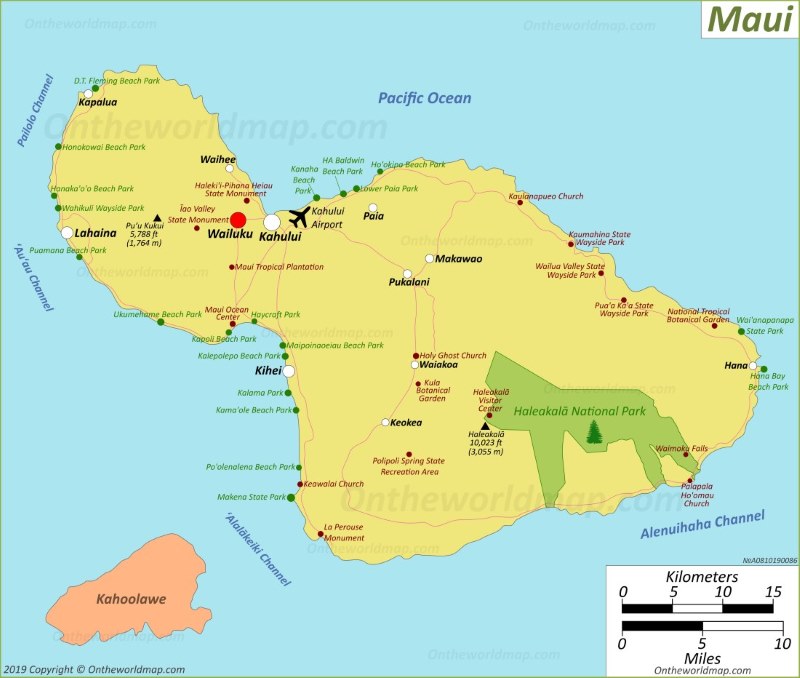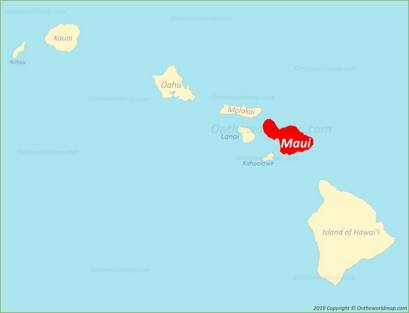Maui Map
Description:
This map shows roads, airport, county seat, cities, towns, villages, national parks, parks, peaks, points of interest, and tourist attractions on Maui Island.
Size: 1100x932px / 147 Kb
Author: Ontheworldmap.com
You may download, print or use the above map for educational, personal and non-commercial purposes. Attribution is required. For any website, blog, scientific research or e-book, you must place a hyperlink (to this page) with an attribution next to the image used.
Maui Location Map
About Maui
Maui is the second-largest island in the Hawaiian archipelago, with an area of 727.2 square miles (1,883 km²). It was formed from two distinct volcanoes, with their valleys eventually merging to form the isthmus between them. The older and extinct volcano, Kahalawai (West Maui Mountains), rises to 5,788 feet (1,764 m), while the larger and younger Haleakalā (East Maui Volcano) reaches 10,023 feet (3,055 m) above sea level. Haleakalā National Park, established in 1976, protects the volcano's massive crater, unique ecosystems, and endangered species.
According to the 2020 census, Maui has a population of approximately 168,307 residents. The island serves as the hub of Maui County, which includes the nearby islands of Lānaʻi, Kahoʻolawe, and Molokaʻi. Kahului is the largest town and commercial center, home to Maui's primary airport and harbor. Other significant communities include Wailuku (the county seat), Lahaina (a historic whaling port and former capital of the Hawaiian Kingdom), Kīhei, Wailea, and Hāna.

The island's economy is primarily driven by tourism, agriculture, and technology. Prior to European contact, Native Hawaiians developed sophisticated agricultural systems including extensive taro cultivation and fishponds. During the 19th and early 20th centuries, sugar and pineapple plantations dominated the economy, bringing workers from various countries and creating Maui's multicultural society. Today, agriculture focuses on diversified crops, while the visitor industry accounts for approximately 80% of the island's economy.
Maui's diverse climate zones result from the mountains' rain shadow effect. The windward (northeastern) slopes receive abundant rainfall, creating lush tropical landscapes, while leeward areas are significantly drier. This climatic diversity supports various ecosystems ranging from coastal environments to alpine zones on Haleakalā's summit. The island's beaches are renowned worldwide, with Kāʻanapali Beach, Wailea Beach, Kapalua Bay, and Makena Beach (also known as Big Beach) consistently ranked among the world's best. The waters surrounding Maui are part of the Hawaiian Islands Humpback Whale National Marine Sanctuary, providing protection for these marine mammals during their winter breeding season.
Transportation infrastructure includes the main airport in Kahului, smaller airports in Kapalua and Hāna, and commercial harbors at Kahului and Lahaina. The island's road system features the Hāna Highway (a famous scenic route with 620 curves and 59 bridges), Honoapiʻilani Highway connecting West Maui to Central Maui, and Haleakalā Highway ascending to the volcano's summit. Public transportation is provided by the Maui Bus system, serving major population centers.
Maui faces several environmental challenges, including water resource management, invasive species, coastal erosion, and development pressures. Conservation efforts focus on watershed protection, native species restoration, and sustainable tourism practices to preserve the island's natural and cultural heritage for future generations.

| State: | Hawaii |
| Largest settlement: | Kahului |
| County: | Maui County |
| Population (2020): | 168,307[1] |
| Density: | 162/sq mi (62.5/sq km) |
| Area: | 727.2 sq mi (1,883 sq km) |
| Coordinates: | 20°48′N 156°18′W |
| Highest elevation: | Haleakalā - 10,023 ft (3055 m) |
List of Cities, Towns ad Villages on Maui
- Kahului
- Kihei
- Wailuku
- Lahaina
- Waihee-Waiehu
- Haiku-Pauwela
- Pukalani
- Makawao
- Napili-Honokowai
- Kula
- Wailea
- Waikapu
- Paia
- Keokea
- Hana
- Olinda
- Kaanapali
- Haliimaile
- Mahinahina
- Launiupoko
- Kapalua
- Ualapu'e
- Maalaea
- Makena
- Olowalu
- Manele
20 Best Beaches on Maui
- Kaanapali Beach
- Wailea Beach
- Makena Beach (Big Beach)
- Kapalua Bay
- Napili Bay
- Hamoa Beach
- Baldwin Beach
- Honolua Bay
- DT Fleming Beach
- Keawakapu Beach
- Palauea Beach (White Rock)
- Mokapu Beach
- Oneuli Beach (Black Sand Beach)
- Kanaha Beach
- Launiupoko Beach
- Ho'okipa Beach
- Slaughterhouse Beach (Mokuleia Bay)
- Olowalu Beach
- Maluaka Beach (Turtle Town)
- Kahekili Beach
Main sights on Maui
- Haleakala National Park
- Road to Hana
- Iao Valley State Park
- Lahaina Historic District
- Molokini Crater
- Waianapanapa State Park (Black Sand Beach)
- Maui Ocean Center
- Banyan Tree Park
- Seven Sacred Pools (Oheo Gulch)
- Hookipa Beach Park
- Ali'i Kula Lavender Farm
- Kaanapali Beach
- Makena State Park (Big Beach)
- Nakalele Blowhole
- Hana Lava Tube
- Twin Falls
- Wailea Beach Path
- Maui Tropical Plantation
- Honolua Bay
- Kealia Pond National Wildlife Refuge
How to get to Maui
By Air:
The main gateway is Kahului Airport (OGG), located on the north-central coast. A smaller airport, Kapalua Airport (JHM), serves West Maui.
Direct flights to Kahului (OGG) from:
- Mainland U.S. cities:
- Los Angeles (LAX)
- San Francisco (SFO)
- Seattle (SEA)
- Portland (PDX)
- San Diego (SAN)
- Phoenix (PHX)
- Las Vegas (LAS)
- Chicago (ORD)
- Dallas (DFW)
- Inter-island flights from:
- Honolulu (HNL)
- Kona (KOA)
- Lihue (LIH)
- Lanai (LNY)
- Molokai (MKK)
Major Airlines Serving Maui:
- Hawaiian Airlines
- Southwest Airlines
- United Airlines
- American Airlines
- Delta Air Lines
- Alaska Airlines
By Sea:
- Cruise ships dock at Kahului Harbor and Lahaina Harbor
- Ferry services:
- Lanai Ferry from Lahaina Harbor
- Molokai Ferry from Lahaina Harbor (seasonal)
Getting Around Maui:
- Rental cars
- Available at both airports
- All major rental companies present
- Advance reservations recommended
- Public transportation
- Maui Bus system
- Connects major towns and attractions
- Shuttle services
- Hotel shuttles
- Airport shuttles
- Resort shuttles
- Taxis and ride-sharing services
Note: Renting a car is recommended for exploring Maui's diverse attractions, including the Road to Hana, Haleakala National Park, and various beach locations. Book well in advance, especially during peak tourist seasons.
References
1. ^ U.S. Census Bureau.U.S. Maps
Maps of Hawaii


